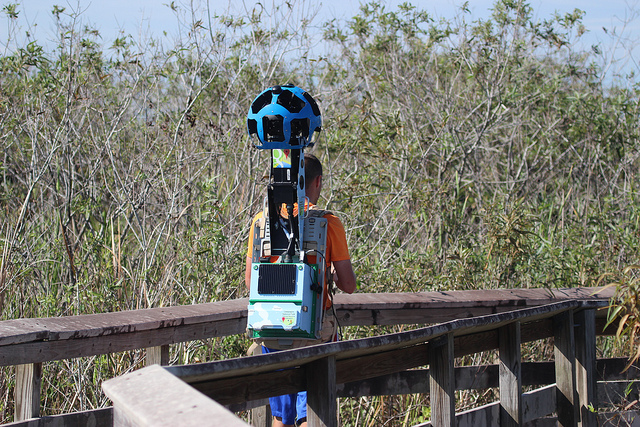Technology
Google gear helps create virtual tours of Georgia sites

The views were captured with a Google Street View Trekker _ a 45-pound backpack with an attached pole topped with a green sphere holding eight cameras, the Telegraph reported. (Photo: cuatrok77/Flickr/CC BY-SA 2.0)
MACON, Ga. – Miles of central Georgia trails and some of Macon’s most prominent historic landmarks can now be toured online on Google Maps.
Ocmulgee National Monument Superintendent Jim David says anyone with an internet connection can take a virtual journey to the top of the mounds and get 360-degree views of the places they’re walking.
The views were captured with a Google Street View Trekker _ a 45-pound backpack with an attached pole topped with a green sphere holding eight cameras, the Telegraph reported.
The device was on loan from Google to the Ocmulgee National Monument Association, a non-profit working to bring recognition to the 700-acre park that’s been occupied by humans since the Ice Age.
The equipment was also used to create tours of Rose Hill Cemetery, Fort Hawkins and Amerson River Park.
“I saw that other national parks in other cities were doing this to try to encourage tourism,” said Billie Coleman, a volunteer for the park’s association who came up with the idea to apply for the Google Street View Trekker. “I thought it would be a great way to showcase a lot of the mounds so people could experience what it was like to be there even if they were never able to come experience this site here.”
Employees of NewTown Macon and the Macon-Bibb Parks and Recreation department helped trek the other sites. Google published the virtual tours online about a year after the trails were trekked.
“Anytime there is an additional tourism offering for people who are visiting, as well as residents of Macon, I think is great,” said Valerie Bradley, director of communications for the Macon-Bibb County Convention & Visitors Bureau.
Sights at Rose Hill Cemetery on Riverside Drive include mausoleums, obelisks and wrought-iron-ringed plots. The cemetery is the final resting place for some of Macon’s most prominent residents, including some of the original members of the Allman Brothers Band, famous architects and masons.
Fort Hawkins was built in 1806, when Georgia was still mostly frontier wilderness, for protection against Native Americans and invasions by the Spanish, British and French, the Macon newspaper reported. It was where militiamen and federal troops were trained for battle, and it is often referred to as the birthplace for modern-day Macon.
Amerson River Park was still being developed when images of it were captured in 2016. The area, on the banks of the Ocmulgee River, was once home to the city’s water treatment plant, which was destroyed in the flood of 1994.





















